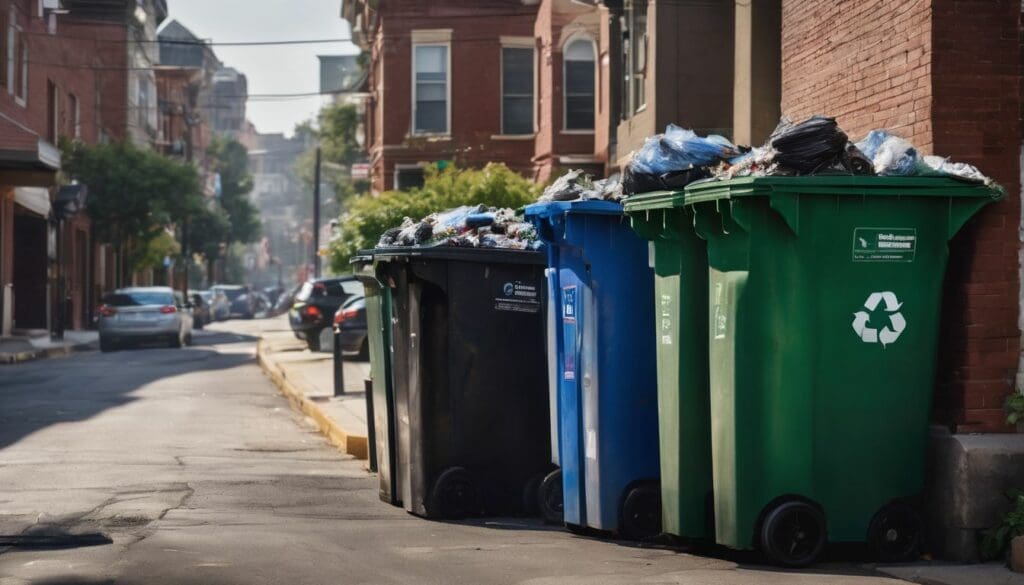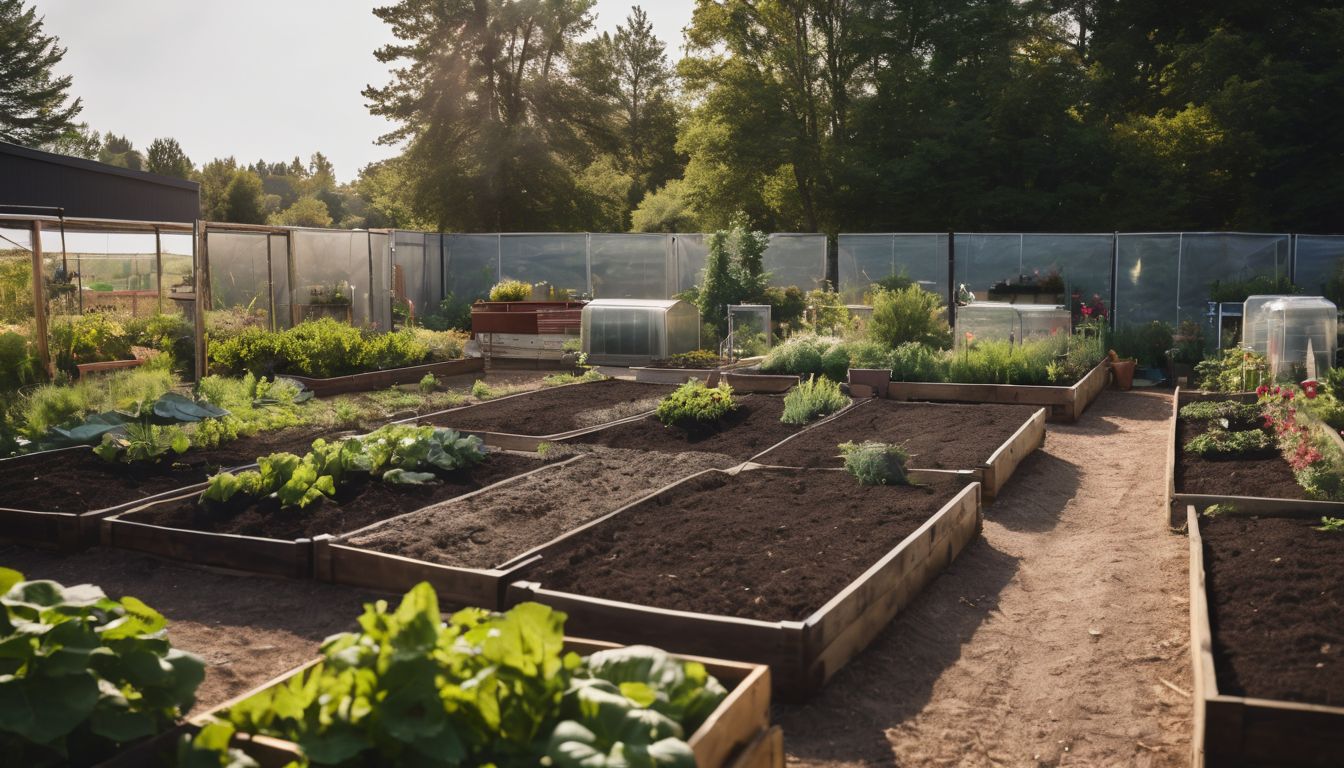We’ve all witnessed the sight of bins brimming over on collection day, haven’t we? It’s a telling reminder that our neighbourhood is more than ready for a robust recycling initiative.
We’re not just talking about it either; with upwards of 2 billion tonnes of waste produced globally each year, action is the need of the hour. Thus, we’ve put our heads together to devise some handy steps to embark on your very own local recycling scheme.
Let’s delve in and make a difference – embracing an eco-friendlier future might be simpler than you imagine!
Key Takeaways
- Starting a local recycling programme has positive impacts, including reducing landfill waste, conserving resources and battling climate change by lowering greenhouse gas emissions.
- A successful programme begins with identifying recyclable materials in the community and choosing effective methods for collection, such as placing bins in high-traffic areas or arranging kerbside pick-up services.
- Education plays a key role; informing community members about the benefits of recycling can drive participation. Workshops, social media outreach and school programmes can boost understanding and engagement.
- Selecting an enthusiastic recycling co – ordinator is crucial to manage operations and motivate others towards achieving the objectives of your local programme.
- Regularly monitoring and evaluating your recycling initiative helps track its success and identifies opportunities for improvement. This includes assessing volumes of recycled materials, analysing feedback from participants and reviewing budget considerations.
Why Recycle?
Recycling is essential for preserving the environment and reducing waste. It helps to conserve natural resources, reduce pollution, and lower greenhouse gas emissions. By recycling, we can contribute to a healthier planet for future generations.
Benefits of Recycling
We all know that recycling turns materials that would otherwise become waste into valuable resources. By doing this, we save space in our landfills, reduce the need for new raw materials, and conserve natural resources like timber, water and minerals.
This process of transforming used items back into raw materials also means less pollution; it often uses far less energy to make a product from recycled materials than it does to produce it from new.
Recycling has an enormous positive impact on greenhouse gas emissions too since manufacturing with recycled goods is generally more energy-efficient. It helps combat climate change by significantly reducing the carbon footprint of production processes.
Beyond these environmental benefits, recycling bolsters the economy as well – many jobs are created when we collect, process and reuse recyclables efficiently. Our commitment to solid waste operations not only protects our planet but nurtures a sustainable future for generations to come.
Environmental Impact
Implementing a local recycling programme has a positive environmental impact. Recycling helps to reduce the amount of waste sent to landfills, conserves natural resources such as water and minerals, and decreases the emissions of greenhouse gases that contribute to climate change.
By promoting recycling initiatives in our community, we can actively engage in sustainable practices and take a step towards environmental stewardship. Recycling also plays a vital role in reducing energy consumption needed for manufacturing new products from raw materials, thereby contributing to environmental conservation efforts.
Furthermore, setting up recycling bins for paper, plastic, glass, and metal at local facilities encourages resource utilisation while minimising solid waste disposal. Implementing composting programmes alongside traditional recycling activities aids in waste reduction and supports eco-friendly practices.
Reducing Waste and Saving Resources
To reduce waste and conserve resources, we can start by identifying materials that are recyclable in our community. By separating these materials from general waste, we can prevent them from ending up in landfills and instead send them to recycling facilities where they can be processed and reused.
This practice not only minimises the amount of waste being disposed of but also reduces the need for new raw materials, ultimately supporting environmental sustainability and eco-friendly practices.
Additionally, by promoting responsible consumption and recycling habits within the community, we can actively contribute to conserving resources for future generations.
How to Start a Recycling Program in Your Community
To start a recycling program in your community, the first step is to identify the materials that can be recycled and determine the best collection methods. Once you have a plan in place, it’s important to educate and involve the community, as well as monitor and evaluate the program for continuous improvement.
Identify Materials to Recycle
To set up a successful recycling programme, we need to identify the materials that can be recycled in our community. Here are the steps for identifying materials to recycle:
- Conduct a waste audit to understand the types and amounts of waste generated.
- Research local recycling facilities to determine what materials they accept.
- Consider common recyclable items such as paper, cardboard, glass, plastic, and metal.
- Identify specific items unique to your community that could be recycled, like electronics or certain plastics.
- Collaborate with local businesses and organisations to explore additional recycling opportunities.
Determine Collection Methods
- Set up designated recycling bins in high-traffic areas for easy access.
- Establish a system for kerbside pickup or drop – off locations to make recycling convenient for the community.
- Collaborate with local businesses and schools to implement collection points at their premises.
- Utilise promotional materials and online resources to educate the community on proper disposal and collection procedures.
- Engage volunteers to help with sorting and transporting recyclable materials to processing facilities.
Create an Improvement Plan
To create an improvement plan for your recycling program, the first step is to set measurable goals. These goals should align with the overall purpose of your program and help you track progress.
Next, consider feedback from the community and make adjustments as needed. Regularly reviewing the effectiveness of your methods will ensure that your recycling efforts continuously improve.
Once specific targets have been identified, develop a timeline for implementing changes. This helps keep everyone accountable and provides a clear path forward. It’s important to involve all stakeholders in this process to foster a sense of ownership and commitment towards achieving these objectives.
Educate the Community
To inform and educate the community about the local recycling programme, environmentally conscious individuals can take the following steps:
- Host workshops and seminars to explain the importance of recycling and its positive impact on the environment. Encourage active participation and provide practical tips for efficient recycling practices.
- Distribute informative flyers, brochures, or newsletters detailing the specific materials that can be recycled in the community. Highlight the environmental benefits and emphasise the significance of resource conservation.
- Collaborate with local schools to introduce educational programmes about recycling to students. Organise interactive activities and projects that promote eco-friendly practices within the school environment.
- Utilise social media platforms and community websites to share engaging content related to recycling facts, tips for reducing waste, and success stories from other communities with thriving recycling programmes.
- Partner with local businesses to raise awareness about responsible waste management and offer incentives for implementing sustainable practices such as reducing single-use plastics or paper products.
Monitor and Evaluate the Program
To ensure the effectiveness of our recycling programme, we regularly monitor and evaluate its performance. This is crucial in ensuring that the programme is achieving its goals and making a positive impact on the environment. Here are some key steps to effectively monitor and evaluate the programme:
- Regularly assess the amount and types of materials being recycled to track progress.
- Analyse any changes in waste production and landfill diversion rates as a result of the recycling efforts.
- Conduct surveys or feedback sessions with community members to gather their input on the programme’s effectiveness and areas for improvement.
- Keep track of any issues or challenges encountered during collection, sorting, or transportation of recyclable materials.
- Review the budget and resource allocation for the recycling programme to ensure it is operating efficiently and cost-effectively.
- Utilise data analysis tools to identify patterns and trends in recycling behaviour within the community.
Tips for Implementing a Successful Recycling Program
When implementing a successful recycling program, it’s important to select a dedicated recycling coordinator who can oversee the operation. Designing and operating the program effectively, along with promoting and monitoring its progress, are also crucial for its success.
Selecting a Recycling Coordinator
When selecting a recycling coordinator, look for someone passionate about environmental conservation. The chosen individual should have strong organisational skills and the ability to motivate others.
They need to be knowledgeable about recycling processes and have good communication abilities.
The coordinator will oversee the day-to-day operations of the recycling programme, ensuring materials are collected in an efficient manner. It’s crucial that they can work well with the community and local authorities to promote and expand the programme when necessary.
Designing and Operating the Program
After selecting a recycling coordinator, it’s essential to focus on designing and operating the programme in a way that maximises efficiency and effectiveness. Here are some key steps to consider:
- Develop a clear plan for collecting recyclables, including the type and location of containers, collection schedules, and transportation methods.
- Establish partnerships with local businesses or organisations to ensure a steady supply of recyclable materials.
- Implement efficient sorting and processing methods to streamline the recycling process and minimise any potential contamination.
- Educate participants on proper recycling practices to improve the quality of materials collected.
- Regularly evaluate the programme’s performance and make adjustments as needed to enhance its overall impact.
Promoting and Monitoring the Program
To ensure the success of our local recycling programme, we need to actively promote and monitor its implementation. Here are some key steps to effectively promote and monitor the programme:
- Organise community events to raise awareness about recycling and the benefits of our programme.
- Utilise social media platforms to engage with the community and provide regular updates on the programme’s progress.
- Collaborate with local schools, businesses, and organisations to spread the word about recycling and encourage participation.
- Offer incentives such as rewards or recognition for individuals or groups who demonstrate outstanding commitment to recycling.
- Conduct regular surveys and feedback sessions to gather input from the community and identify areas for improvement in our programme.
Conclusion
Starting a local recycling program requires dedication and planning. Identifying materials to recycle, determining collection methods, and creating an improvement plan are crucial steps.
A well-educated community and regular monitoring are essential for success. With the right approach, setting up a local recycling program can make a significant impact on the environment.
FAQs
1. How do we start a local recycling program in our community?
To kickstart a local recycling program, begin with a clear plan for gathering and sorting recyclables. Reach out to your community members, get support from local businesses and authorities, and ensure everyone knows how to contribute.
2. What are the first steps in implementing a recycling program?
Start by researching what materials can be recycled locally and decide on methods for collection and processing. Educate the community about eco-friendly practices and set up convenient drop-off points or curbside pickup schedules.
3. Can I make my neighborhood more eco-friendly through recycling?
Absolutely! Encourage neighbors to join the local recycling program you’re setting up, which promotes ecofriendly practices and helps reduce waste in your area.
4. What should we consider when setting up our community’s recycling scheme?
Consider factors such as funding sources for bins and equipment, engaging volunteers to help run the program smoothly, partnering with waste management services, and regularly informing residents about the benefits of participating in your eco-friendly initiative.





